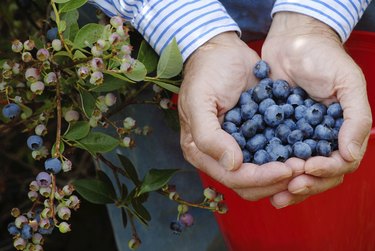
Whether you're starting a commercial crop or planting a few bushes for your own use, blueberries (Vaccinium spp.) have the potential to thrive in Wisconsin. Though adaptable to a wide range of climates -- blueberries can be grown in U.S. Department of Agriculture plant hardiness zones 3 through 11 depending on species and cultivar -- they have very specific soil requirements. This can make growing them a challenge in Wisconsin, but with soil modifications and proper care, blueberry bushes can bear fruit for 30 years or more.
Selecting Cultivars
Video of the Day
The first step to growing blueberries successfully in Wisconsin is choosing cultivars that are well adapted to the climate and can withstand cold winter temperatures. With winter lows ranging from -10 to -35 degrees Fahrenheit, Wisconsin falls within USDA zones 3 to 5. Several blueberry cultivars are suited to this range.
Video of the Day
Most of the best blueberry cultivars for Wisconsin are a cross between high-bush blueberries (Vaccinium corymbosum) and low-bush blueberries (Vaccinium angustifolium), known as half-high blueberries (Vaccinium corymbosum x angustifolium). Blueberry cultivars for Wisconsin include "Northblue," "Northsky," "Northcountry," "St. Cloud," "Polaris," "Chippewa" and "Northland." Each of these cultivars is suitable for USDA zones 3 to 5.
Selecting a Growing Site
Sunlight is important for blueberry production, and the plants will grow best in a site with full sun. Blueberries can tolerate light to moderate shade, but increased shade means reduced blooming and lower fruit production. Avoid planting blueberries in a location where nearby trees cast shade and compete for nutrients.
The ideal location for growing blueberries should have moist, well-drained, acidic sandy loam soil with lots of organic content. An open site with level or gently sloping ground is best. Avoid low-lying sites where water gathers, and steer clear of peat, muck and clay soils.
Testing and Modifying the Soil
Soil pH is the characteristic that typically creates the greatest challenge for growing blueberries in Wisconsin. Blueberries need acidic soil with a pH between 4.0 to 5.5. Wisconsin soils tend to be more alkaline, and soils with a pH higher than 5.8 can cause iron chlorosis or death with prolonged exposure. To grow blueberries in Wisconsin, you will almost certainly need to amend your soil before planting.
A variety of methods can be used to lower pH. In many cases, mixing 4 to 6 inches of acid peat into the top 6 to 8 inches of soil can reduce the pH to within blueberries' tolerance. Sulfur compounds such as elemental sulfur can also be used to reduce pH. Elemental sulfur must be added to the soil at least one year before you plant blueberries, and the amount you must use depends on what type of soil you are starting with.
If you are unsure of your soil type and current pH, you can send a sample to the nearest University of Wisconsin soil testing laboratory to have it tested. The test results will include the pH and recommendations for soil amendments. You can find your nearest soil testing laboratory through the University of Wisconsin website.
Planting and Care
You can plant blueberries in either spring or fall, but spring is ideal. In southeast Wisconsin -- the warmest part of the state -- you can plant blueberries in late April. farther north, it's best to wait until May to reduce the risk of frost damage. Space blueberry plants 3 to 4 feet apart in holes large enough to accommodate all the roots and deep enough that you can cover the topmost roots with 3 to 4 inches of soil. Pack the soil firmly around the roots.
Add 2 to 4 inches of surface mulch around the plants to help the roots maintain moisture and protect them from temperature extremes, but keep mulch from touching the base of plants. Suitable mulching materials include peat moss, sawdust and chopped straw. Water the plants at the time of planting, and continue to do so as often as is necessary to keep the soil moist, but not saturated. Fertilize annually with an acid-producing fertilizer such as ammonium sulfate in early spring, applying 0.5 to 1 pound of ammonium sulfate per 100 square feet. Remove blossoms during the first two years of the plants' lives to encourage growth.
- University of Minnesota: Commercial Blueberry Production in Minnesota and Wisconsin
- University of Minnesota: Blueberries for Home Landscapes
- Edible Madison: Blueberries
- United States Department of Agriculture: USDA Plant Hardiness Zone Map
- The Old Farmer's Almanac: Blueberries
- Oregon State University: Oregon Blueberry Newsletter
- National Gardening Association: Blueberry Prescription
- University of Wisconsin: Lowering Soil pH
- University of Wisconsin: Lawn & Garden Testing